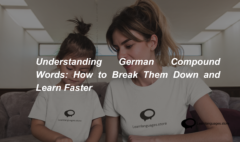How to Learn German Easily: Sharing News, Describing People, and Mastering Key Grammar
How to Learn German Easily: Sharing News, Describing People, and Mastering Key Grammar
Estimated reading time: 9 minutes
INTRODUCTION:
Learning German at the B1 level is an exciting journey that becomes even more engaging when you can relate it to everyday activities like sharing information from newspaper articles, discussing art and fashion, or describing people and things in detail. In this blog, we’ll explore these themes while diving into essential German grammar concepts such as the Doppeltes Perfekt, Verneinung (negation), and Komplexe Relativsätze (complex relative clauses). Additionally, we’ll provide a vocabulary table with examples and Hindi pronunciation guides to help you grasp the material more easily. Let’s get started on enhancing your German skills!

1. Sharing Information from Newspaper Articles (Informationen aus Zeitungstexten weitergeben)
Understanding and relaying information from newspaper articles is a practical skill, especially in German. This involves not just reading comprehension but also the ability to summarize and communicate the main points effectively.
Example:
- German: In dem Artikel steht, dass die Arbeitslosenquote gesunken ist.
- English: The article says that the unemployment rate has decreased.
- Hindi Pronunciation: इन डेम आर्टिकल श्टेट, दास दी आर्बाइट्स्लोज़नक्वोटे गेशुन्कन इश्ट।
Tip: When summarizing a newspaper article, focus on the key facts and figures, and practice paraphrasing in your own words to reinforce your understanding.
2. Asking Follow-Up Questions (Nachfragen)
Asking questions is essential for clarifying information and engaging in meaningful conversations in German. This skill is particularly useful in both everyday life and professional settings.
Example:
- German: Könnten Sie das bitte wiederholen?
- English: Could you please repeat that?
- Hindi Pronunciation: कोन्टेन ज़ी दास बिट्टे विदरहोलन?
Grammar Note: When asking follow-up questions, polite forms like “könnten” (could) and “bitte” (please) are often used to make the request more courteous.
3. Negating Something (Etwas verneinen)
Negation is a crucial aspect of expressing yourself clearly in German. Understanding how to use “kein,” “nicht,” and “nichts” allows you to deny something effectively.
Verneinung: kein, nicht, nichts
Example 1:
- German: Ich habe keinen Hund.
- English: I don’t have a dog.
- Hindi Pronunciation: इश हाबे कैनन हुंड।
Example 2:
- German: Er ist nicht zu Hause.
- English: He is not at home.
- Hindi Pronunciation: एर इश्ट निख़्ट त्सू हाउज़े।
Example 3:
- German: Ich habe nichts gehört.
- English: I didn’t hear anything.
- Hindi Pronunciation: इश हाबे निख़्ट्स गेहॉर्ट।
Grammar Note:
- “Kein” is used to negate nouns and means “no” or “not any.”
- “Nicht” is used to negate verbs, adjectives, and entire clauses.
- “Nichts” means “nothing” and is used to express the absence of something.
4. Talking About Pictures (Über Bilder sprechen)
Discussing images and expressing opinions about them is a great way to practice descriptive language in German.
Example:
- German: Das Bild zeigt eine Landschaft mit Bergen im Hintergrund.
- English: The picture shows a landscape with mountains in the background.
- Hindi Pronunciation: दास बिल्ड त्साइग्त आइने लांडशाफ्ट मिट बेरगन इम हिंटग्रुंड।
Vocabulary Table:
| German Word | Meaning | Example Sentence | Hindi Pronunciation |
|---|---|---|---|
| Kunst | Art | Die Kunst ist sehr abstrakt. | दी कुंस्ट इश्ट ज़ेयर अब्स्ट्राक्ट। |
| Mode | Fashion | Mode aus Schokolade ist einzigartig. | मोडे आऊज़ शोकलादे इश्ट आइंज़िगार्टीग। |
| Gefühle | Emotions | Musik drückt starke Gefühle aus. | म्युज़िक ड्रुक्ट श्टार्के गेफूले आऊज़। |
| Gerüchte | Rumors | Es gibt viele Gerüchte über den Schauspieler. | एश गिब्त फीलें गरूख़्टे उबर डेन शाऊश्पीलेर। |
5. Saying What You Like (Sagen, wie einem etwas gefällt)
Expressing your likes and dislikes is an important conversational skill in German.
Example:
- German: Mir gefällt dieses Lied sehr gut.
- English: I really like this song.
- Hindi Pronunciation: मीर गेफेल्ट डीजेस लीड ज़ेयर गुट।
Cultural Note: Germans often use the phrase “Mir gefällt…” to express what they like, whether it’s music, art, or food. It’s a common way to engage in discussions about personal preferences.
6. Understanding a Course Program (Ein Kursprogramm verstehen)
Being able to read and understand a course program in German is essential for planning your studies or activities.
Example:
- German: Der Kurs beginnt um 9 Uhr und endet um 12 Uhr.
- English: The course starts at 9 AM and ends at 12 PM.
- Hindi Pronunciation: डेर कोर्स बगिन्ट उम नॉइन ऊर उंड एन्डेट उम त्स्वेल्फ ऊर।
Tip: Pay attention to the schedule, course content, and requirements listed in the program to ensure you meet all necessary prerequisites.
-
Product on sale
 German B1
German B1₹32,600.00
₹36,300.00 -
Product on sale
 German A2
German A2₹18,300.00
₹24,300.00
7. Describing People or Things in Detail (Personen oder Dinge genauer beschreiben)
Describing people or objects with precision is a key skill at the B1 level, allowing you to communicate more effectively.
Example:
- German: Sie ist eine große Frau mit langen, braunen Haaren.
- English: She is a tall woman with long, brown hair.
- Hindi Pronunciation: ज़ी इश्ट आइने ग्रोसे फ्राउ मिट लंगेन, ब्राउनन हारन।
**Grammar Point: ** Komplexe Relativsätze (Complex Relative Clauses)
Example:
- German: Das ist der Mann, dessen Auto kaputt ist.
- English: That is the man whose car is broken.
- Hindi Pronunciation: दास इश्ट डेर मान, डेसेन ऑटो कपुट इश्ट।
Grammar Note: Relative clauses provide additional information about a noun mentioned earlier in the sentence. In complex sentences, they help create detailed descriptions:
- “Der Mann, dessen Auto kaputt ist” means “The man whose car is broken.” “Dessen” is the relative pronoun used for masculine and neuter nouns in the genitive case, indicating possession.
8. Understanding and Writing Advertisements (Anzeigen verstehen und schreiben)
Knowing how to interpret and write ads in German is a practical skill, whether you’re looking for a job, apartment, or selling something.
Example:
- German: Zu vermieten: Eine Wohnung mit zwei Schlafzimmern in zentraler Lage.
- English: For rent: An apartment with two bedrooms in a central location.
- Hindi Pronunciation: त्सू फेरमीटेन: आइने वोहनुंग मिट त्स्वाई श्लाफ़्त्सिमरन इन त्सेंट्रालर लागे।
Tip: Pay attention to key details like price, location, and features when writing or interpreting ads.
9. Understanding an Interview or Improvised Story (Ein Interview und eine Impro-Geschichte verstehen)
Listening comprehension, especially in spontaneous or improvised contexts like interviews or stories, is crucial at the B1 level.
Example:
- German: Im Interview erzählte sie von ihrer Reise durch Afrika.
- English: In the interview, she talked about her trip through Africa.
- Hindi Pronunciation: इम इंटेरव्यू एर्ट्सैलटे ज़ी फॉन ईरर राइज दुख़ आफ्रिका।
Cultural Note: Improvised storytelling and interviews are common in German media, providing insight into cultural attitudes and humor. Being able to follow these stories will deepen your understanding of the language and culture.
10. Grammar Point: Doppeltes Perfekt (Double Perfect Tense)
The Doppeltes Perfekt is used primarily in spoken German to emphasize that an action was completed before another past action. It’s common in southern German dialects and colloquial speech.
Example:
- German: Er hat es vergessen gehabt.
- English: He had forgotten it.
- Hindi Pronunciation: एर हाट एस फेर्गेस्सन गेहाब्त।
Grammar Note:
In the Doppeltes Perfekt, the structure involves using the perfect tense of the auxiliary verb (hat/ist) and the past participle of the main verb, followed by the past participle of “haben” or “sein” to emphasize the past action’s completion.
11. Vocabulary Table for B1 German Level
| German Word | Meaning | Example Sentence | Hindi Pronunciation |
|---|---|---|---|
| Kunst | Art | Kunst ist ein Ausdruck von Kreativität. | कुंस्ट इश्ट आइन आऊसड्रुक फॉन क्रेआटिविटेट। |
| Mode | Fashion | Mode ist in Berlin sehr beliebt. | मोडे इश्ट इन बर्लिन ज़ेयर बेलिब्ट। |
| Gefühle | Emotions | Gefühle sind schwer zu beschreiben. | गेफूले ज़िंड श्वेर त्सू बेश्राइबन। |
| Gerüchte | Rumors | Gerüchte verbreiten sich schnell. | गरूख़्टे फरब्राइटन ज़िख़ श्नेल। |
12. Cultural Note: Street Art in Berlin and Fashion Made of Chocolate
Street Art in Berlin: Berlin is renowned for its vibrant street art scene, which reflects the city’s history, politics, and diverse culture. The Berlin Wall’s East Side Gallery is a prime example, where artists from around the world have transformed a symbol of division into one of expression and unity.
Mode aus Schokolade (Fashion Made of Chocolate): In Germany, there’s an annual fashion show where designers create stunning outfits entirely out of chocolate. This event combines the culinary arts with haute couture, showcasing creativity in a deliciously unique way.
Enhance Your German Skills!
To improve your German further, consider enrolling in our A1 Level German Course at Learn Languages Store for just Rs. 16,300. Our courses are designed to help you build a strong foundation in the German language in a fun and engaging way.
Contact Us to Learn More!
For more information about our courses, feel free to reach out to us at:
Address:
330, 3rd Floor, Big Splash (Near Vashi Bus Depot),
Sector 17, Vashi,
Navi Mumbai, Maharashtra 400703
Phone: +91-9594113111
Email: services@learnlanguages.store
Don’t miss the opportunity to enhance your language skills! Sign up today and start your journey to fluency in German!
Conclusion:
Mastering German at the B1 level is not just about learning grammar and vocabulary; it’s about connecting these elements to real-life scenarios like discussing art, fashion, and sharing information effectively. By practicing how to ask questions, negate statements, and use complex sentences, you’ll enhance your ability to communicate clearly in German. Incorporate the vocabulary and grammar points provided here into your daily practice, and soon you’ll find yourself more confident in your German language skills.










